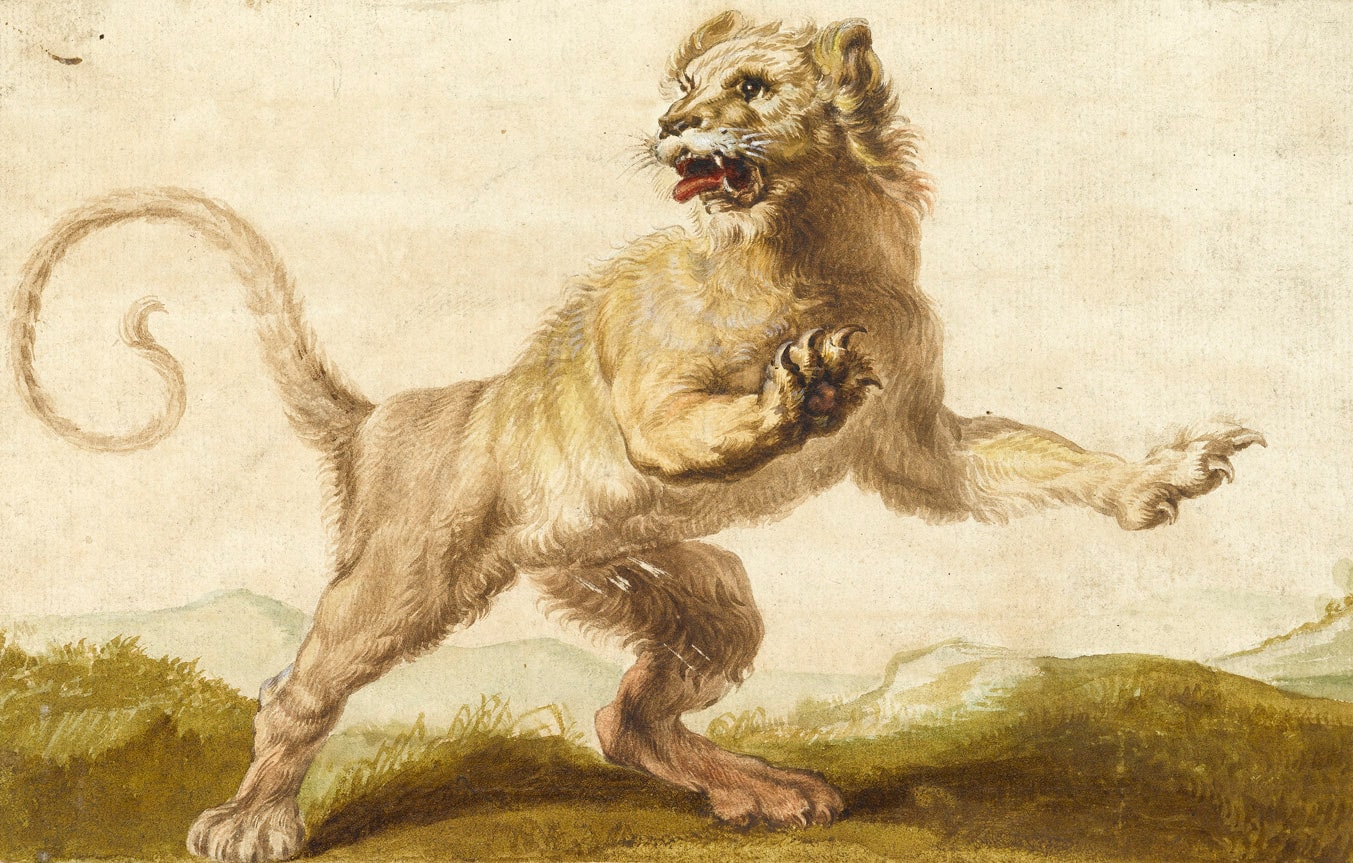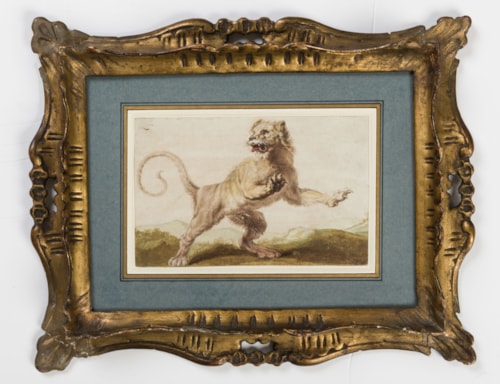Carl Andreas RUTHART (attr.)
(Danzig 1630 - L'Aquila 1703)
A Lion, after Rubens
Watercolour and gouache.
Inscribed (by Arthur Feldmann) Karl Andreas Ruthart / Aufgescheuchte Lowen on the verso.
127 x 197 mm. (5 x 7 3/4 in.)
Inscribed (by Arthur Feldmann) Karl Andreas Ruthart / Aufgescheuchte Lowen on the verso.
127 x 197 mm. (5 x 7 3/4 in.)
The traditional attribution of the present sheet to Carl Andreas Ruthart, while tentative, would seem to be worth considering in light of the artist’s penchant for leaping animals in his paintings. The lion depicted in this drawing is based, in reverse, on part of an etching of two young lions at play by Abraham Blooteling after Peter Paul Rubens. Blooteling’s print is one of a set of four etchings of lions, each after designs by Rubens, published as Variae Leonum Icones sometime in the second half of the 17th century. The draughtsman may have been derived his composition from Blooteling’s print, or a contemporary, reversed copy of it. The same lion was used by Frans Snyders in a painting of Two Lions Pursuing a Roebuck of c.1620-1625, today in the Alte Pinakothek in Munich, and for a painting of The Lion and the Mouse of about the same date, at Chequers Court in Buckinghamshire.
An impression of the related etching by Abraham Blooteling is sold with this drawing.
An impression of the related etching by Abraham Blooteling is sold with this drawing.
Born in Danzig (modern-day Gdansk in Poland) around 1630, Carl Borromäus Andreas Ruthart was largely self-taught as an artist, and established a reputation as a painter of wild animals and hunting scenes. He was briefly in Rome in 1659 before being admitted to the painter’s guild in Antwerp in 1664, while later that year he is documented in Regensburg. Between 1665 and 1667 Ruthart was in Vienna, working for Prince Karl Eusebius von Liechtenstein. In 1672 he became a monk of the Celestine order at the monastery of Sant’ Eusebio in Rome, later transferring to the monastery of Santa Maria di Collemaggio in L’Aquila, in the Abruzzo region northeast of Rome, where he seems to have lived and worked for the rest of his life. Known as Pater Andrea, he is still documented there in 1703, and is assumed to have died not long afterwards. Although best known and most successful as a painter of wild animals, Ruthart also painted a handful of religious works for the churches with which he was associated, namely two altarpieces for Sant’ Eusebio in Rome and fourteen scenes from the life of the founder of the Celestine order for the church at L’Aquila.
Highly esteemed in his lifetime, Ruthart’s animal paintings found their way into several important European collections, including those of the Archduke Leopold Wilhelm, Field Marshal von der Schulenberg and Count Bruhl, as well the Liechtenstein, Harrach, Czernin and Esterhazy collections. Paintings by Ruthart were also owned by the Dukes of Devonshire and the Earls of Shrewsbury.
Provenance
Dr. Arthur Feldmann, Brno
Looted by the Gestapo on 15 March 1939, during the Nazi occupation of Moravia
Anonymous sale, London, Sotheby’s, 16 October 1946, part of lot 55
Sir Robert Witt, London (Lugt 2228b)
Bequeathed by him to the Courtauld Institute of Art, London in 1952
Restituted to the heirs of Arthur Feldmann in 2007.
Looted by the Gestapo on 15 March 1939, during the Nazi occupation of Moravia
Anonymous sale, London, Sotheby’s, 16 October 1946, part of lot 55
Sir Robert Witt, London (Lugt 2228b)
Bequeathed by him to the Courtauld Institute of Art, London in 1952
Restituted to the heirs of Arthur Feldmann in 2007.
Literature
London, Courtauld Institute of Art, Hand-list of the Drawings in the Witt Collection, 1956, p.155, no.3852 (as Ruthart); Sir David Hirst, Report of the Spoliation Advisory Panel in Respect of Three Drawings now in the Possession of the Courtauld Institute of Art, London, 2007.



-ALionafterRubens-25102015T132514.jpg?width=500&height=1000&qlt=80&format=jpg&mode=max)


